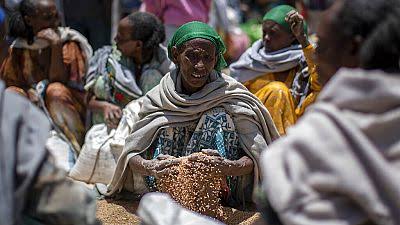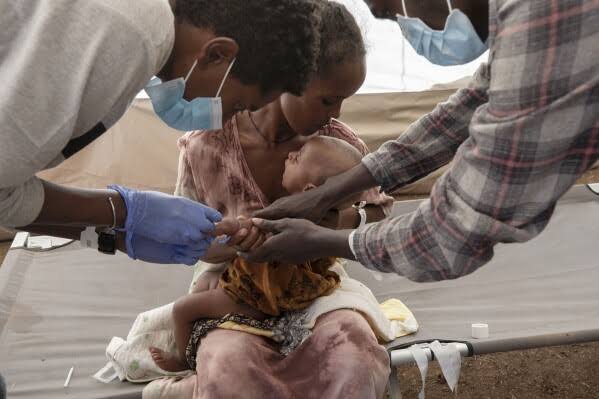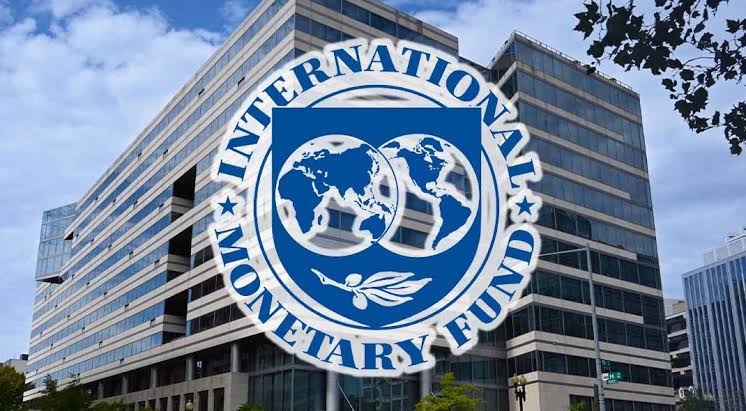
Faith Nyasuguta
In the arid heart of Ethiopia’s Tigray region, a cruel intersection of war, drought, and aid mismanagement has given rise to a dire humanitarian crisis.
Tinsue Hiluf , a widow grappling with the harsh realities of life, finds herself raising her sister’s four children. Her tale is one of profound suffering, woven from the threads of a two-year war that claimed the life of one of her sons.
Now, in the aftermath of conflict, the youngest among the children faces the threat of malnutrition, a consequence of the region’s pervasive food scarcity exacerbated by drought.
This is not an isolated story. It is a microcosm of Tigray, a region that once bore the brunt of a deadly war between federal troops and forces loyal to the ousted ruling party. As the region attempts to transition from conflict to peace, the shadows of war linger, casting a long and ominous pall over the lives of its residents.
The scars of conflict are visible not only in the lives lost but also in the once-lush fields that now lie barren. The faces of mothers, etched with worry, tell tales of helplessness as their children weaken from malnutrition.
Tigray, home to 5.5 million people, stands at the crossroads of desperation, with nearly 400 reported deaths from starvation in the six months leading up to January. It’s a stark admission of hunger-related deaths by the federal government—a rare acknowledgment of the depth of the crisis.
The peace agreement signed in November 2022 was meant to signal a shift toward stability, but the realities on the ground tell a different story. Tigray, once a thriving agricultural landscape, is now a canvas of desolation.
Once-fertile fields, crucial for the region’s sustenance, remain unplanted, victims of both conflict and drought. The consequences are severe, with only 49% of Tigray’s farmland planted during the main season last year. And even in the areas that were cultivated, crop production reached a mere 37% of the expected total due to the relentless grip of drought. In some regions, this figure plummeted to a staggering 2%.
In the aftermath of the conflict, Tigray faced not only the challenge of rebuilding but also the repercussions of aid mismanagement. A massive scheme orchestrated by Ethiopian officials to pilfer humanitarian grain prompted the United Nations and the United States to temporarily suspend deliveries, further deepening the crisis. The inadequate growing season that followed painted a grim picture of food scarcity.
Finarwa, a farming community of about 13,000 people, is among the hardest-hit places. Its health center, still bearing the wounds of war, has become a refuge for those seeking help amid the pervasive hunger.

The stories echo in the desperation of mothers at the center, where one laments the absence of breastmilk for her eight-month-old baby, and another, with 1-year-old twins, pleads for sachets of baby food to keep her babies alive.
The images painted by the people of Finarwa depict a region on the brink—a place where hunger forces children to flee in search of sustenance, a place where even local leaders, burdened by the scarcity, find themselves unable to provide assistance.
The haunting specter of the 1980s famine, which claimed the lives of hundreds of thousands across northern Ethiopia, looms large as Tigray teeters on the edge of another humanitarian catastrophe.
The challenges extend beyond hunger, encompassing the very basics of survival. Access to water—a fundamental need—has become a luxury for many in Tigray.
Of the 25 wells that once sustained communities and their animals, only five remain functional. The arduous journey to fetch water, which now takes over an hour and a half, underscores the profound impact of the region’s drought.
The resilience of farmers like Haile Gebre Kirstos, who, at 70, continues to plow his parched land, speaks to the indomitable spirit of a people confronting adversity.
Yet, his early plowing this year, driven by extreme need, is a testament to the urgency of the situation. Farmers, in a bid to feed their families, have sold their oxen and farming tools, sacrificing their means of livelihood for survival.
Tigray, once a beacon of hope even for those displaced by war, now stands at the precipice of a humanitarian abyss. The war took everything—livelihoods, sustenance, and the promise of a better future. The echoes of the 1980s famine reverberate, with some districts facing conditions as dire as or worse than that dark chapter in history.
In the face of such multifaceted challenges, Tigray calls for urgent global attention and coordinated efforts to alleviate the suffering of its people.
The convergence of war, drought, and aid mismanagement has painted a complex tapestry of despair—a tapestry that demands not just empathy but tangible and immediate intervention to avert a catastrophe.
RELATED:




